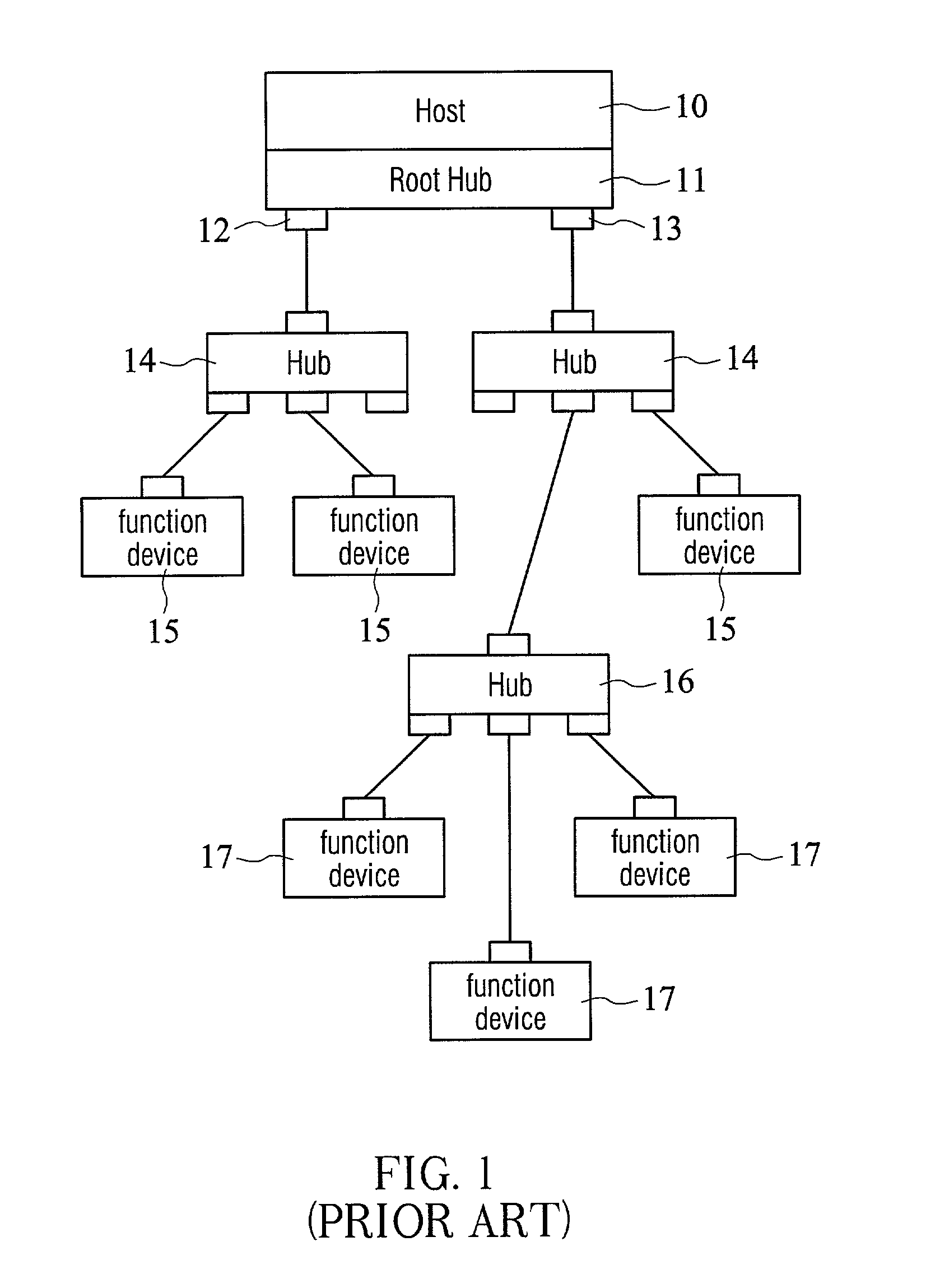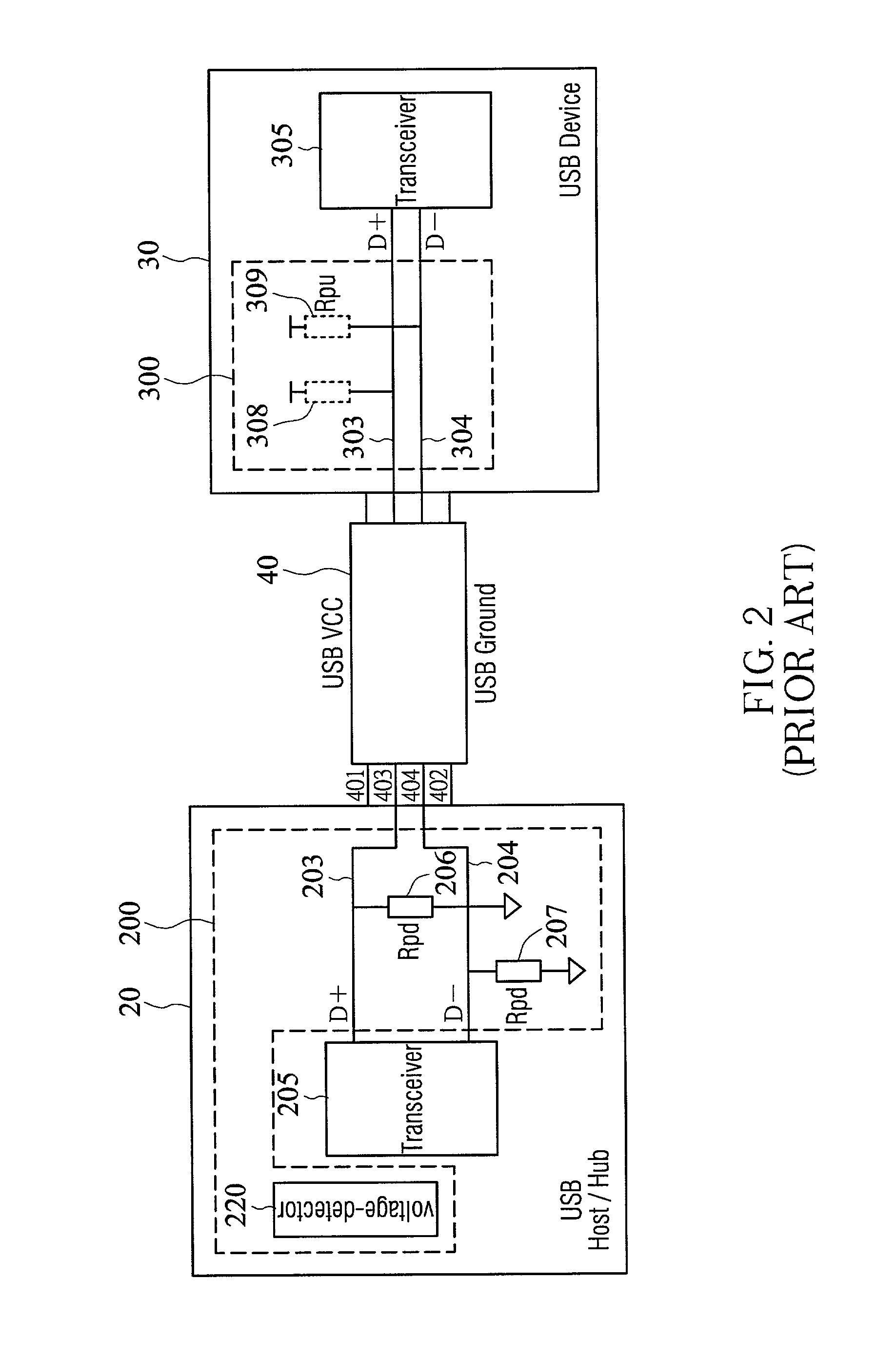USB connection-detection circuitry and operation methods of the same
a technology of usb connection and operation method, applied in the direction of instruments, computing, electric digital data processing, etc., can solve the problem of forbidden data transmission directly from one usb function device to another usb function devi
- Summary
- Abstract
- Description
- Claims
- Application Information
AI Technical Summary
Benefits of technology
Problems solved by technology
Method used
Image
Examples
first embodiment
[0026] Refer to FIG. 3, a connection-detection circuitry of the first embodiment according to the present invention is shown in the figure. The Connection-detection circuitry 500 includes a pair of differential signal lines 503, 504, a pair of pull-down resistor 506, 507, a pair of pull-up resistor 508, 509, a power supply system 510, and a set of manual switching elements 511. Wherein, the differential signal line 503 is used to connect to a D+ differential signal Line 403 of a USB cable 40 while the differential signal line 504 is used to connect to a D- differential signal line 404 of the USB cable 40. The connection-detection circuitry 500 of this embodiment is a manual-switch mode circuitry.
[0027] If a USB "Devicehost" device 50 containing such connection-detection circuitry 500 is to be connected to a USB host or a USB hub device, the user can use a set of manual-switch elements 511 to set the USB Devicehost device 50 into "Device-Mode" before the connection. Under Device-Mode...
second embodiment
[0032] With reference to FIG. 4a and 4b, a connection-detection circuitry 600 of the second embodiment according to the invention is shown in the figures. The connection-detection circuitry 600 includes a pair of differential signal lines 603, 604, a power line 611, a ground line 612, a pair of pull-down resistors 606, 607, a pair of pull-up resistors 608, 609, a power supply system 610, and a current-detection circuit 620. Wherein, the differential signal lines 603, 604 are used to connect to the D+ and D- differential signal line 403, 404 of the USB cable 40 ; while each of the pull-down resistors 606 and the pull-up resistor 608 is connected to the differential signal line 603 with a switching element, and each of the pull-down resistor 607 and the pull-up resistor 609 is connected to the differential line 604 with a switching element, separately. Further, a timer 621 is constructed in the current-detection circuit 620 and will be explained in details later. Besides, the power su...
third embodiment
[0042] Refer to FIG. 5a and 5b, a connection-detection circuitry 700 of the third embodiment according to the invention is shown in the figures. The connection-detection circuitry 700 of Voltage-Detection Mode includes a pair of differential signal lines 703, 704, a power line 711, a ground line 712, a pair of pull-down resistors 706 and 707, a pair of pull-up resistors 708 and 709, a pair of up-stream resistors 701 and 702, a power supply system 710, and a voltage-detection circuit 720. Wherein, the differential signal lines 703 and 704 are used to connect to the D+ and D- differential signal lines 403 and 404 of the USB cable 40, respectively. Each of the pull-down resistor 706, the pull-up resistor 708 and the up-stream resistor 701 is connected to the differential signal line 703 with a switching element, individually. Meanwhile, each of the pull-down resistor 707, the pull-up resistor 709, and the up-stream resistor 702 is connected to the differential signal line 704 with a sw...
PUM
 Login to View More
Login to View More Abstract
Description
Claims
Application Information
 Login to View More
Login to View More - R&D
- Intellectual Property
- Life Sciences
- Materials
- Tech Scout
- Unparalleled Data Quality
- Higher Quality Content
- 60% Fewer Hallucinations
Browse by: Latest US Patents, China's latest patents, Technical Efficacy Thesaurus, Application Domain, Technology Topic, Popular Technical Reports.
© 2025 PatSnap. All rights reserved.Legal|Privacy policy|Modern Slavery Act Transparency Statement|Sitemap|About US| Contact US: help@patsnap.com



